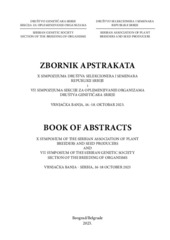Приказ основних података о документу
Moderni trendovi u oplemenjivanju suncokreta
Modern trends in sunflower breeding
| dc.creator | Jocković, Milan | |
| dc.creator | Jocić, Siniša | |
| dc.creator | Cvejić, Sandra | |
| dc.creator | Ćuk, Nemanja | |
| dc.creator | Miladinović, Dragana | |
| dc.creator | Miklič, Vladimir | |
| dc.creator | Krstić, Miloš | |
| dc.creator | Marjanović-Jeromela, Ana | |
| dc.creator | Jocković, Jelena | |
| dc.creator | Hladni, Nada | |
| dc.creator | Ovuka, Jelena | |
| dc.date.accessioned | 2023-11-11T17:05:56Z | |
| dc.date.available | 2023-11-11T17:05:56Z | |
| dc.date.issued | 2023 | |
| dc.identifier.isbn | 978-86-87109-17-9 | |
| dc.identifier.uri | http://fiver.ifvcns.rs/handle/123456789/3986 | |
| dc.description.abstract | Prema trenutnom trendu rasta svetske populacije očekivanja su da će ukupan broj stanovnika do 2050. godine iznositi 9,6 milijardi, što je povećanje više od 10% u odnosu na trenutnu situaciju. Pored toga, prosečna svetska temperatura raste i beleži rekorde svake godine, praćena abnormalnim klimatskim fenomenima poput superćelijskih oluja. Pored mnogobrojnih biotičkih faktora koji stvaraju probleme u gajenju useva, rekordne temperature uz nepredvidive obrazce padavina predstavljaju sve izazovnije uslove za uspešnu proizvodnju. Na globalnom nivou, suncokret predstavlja stratešku ratarsku biljnu vrstu, zbog povećanja tražnje za njegovim uljem kao i relativno umerenih zahteva za proizvodnju, u odnosu na druge useve. Imajući u vidu navedene činjenice, od suštinskog je značaja primenjivati inovativne tehnike u oplemenjivanju suncokreta u svrhu razvoja genotipova sposobnih da se odupru izazovima biotičkog i abiotičkog stresa kao što su različite štetočine, bolesti, visoke temperature, suša i dr. S tim u vezi, neki od aktuelnih trendova u oplemenjivanju biljaka, suncokreta su precizna modifikacija gena unutar genoma (CRISPR-Cas9), digitalizovano oplemenjivanje zasnovano na velikom setu podataka uz primenu bioinformatike u cilju genomskog predviđanja, kao i precizna fenotipizacija i primena epigenetike u svrhu oplemenjivanja na tolerantnost prema abiotskim faktorima izazvanim učestalim klimatskim promenama (climate resilient varieties). Jedan od takvih pristupa jeste SMARTSUN projekat Instituta za ratarstvo i povrtarstvo iz Novog Sada koji primenom savremenih metoda precizne fenotipizacije uz genotipska i epigenetska istraživanja ispituje mehanizme prilagođavanja suncokreta na ekstremne abiotske faktore, prvenstveno sušu, kao sve češću pojavu izazvanu klimatskim neregularnostima. | sr |
| dc.description.abstract | According to the current trend of world population growth, expectations are that the total number of inhabitants will reach 9.6 billion by 2050, which is an increase of more than 10% compared to the current situation. In addition, the average global temperature is rising and setting records every year, accompanied by abnormal climate phenomena such as supercell storms. In addition to numerous biotic factors that create problems in growing crops, record temperatures and unpredictable rainfall present increasingly challenging conditions for successful production. At the global level, sunflower represents a strategic field crop specie, due to the increasing demand for its oil, as well as relatively moderate production requirements, compared to other crops. Bearing in mind the above facts, it is essential to apply innovative techniques in sunflower breeding in order to develop genotypes capable of resisting the challenges of biotic and abiotic stress such as various pests, diseases, high temperatures, drought, etc. In this regard, some of the current trends in plant breeding, including sunflower, are precise gene modification within the genome (CRISPR-Cas9), digitized breeding based on a large data set with the application of bioinformatics for genomic prediction, as well as precise phenotyping and the application of epigenetics for the purpose of breeding for tolerance to abiotic factors caused by frequent climate changes (climate resilient varieties). One of such approaches is the SMARTSUN project of the Institute of Field and Vegetable Crops from Novi Sad, which, using modern methods of precise phenotyping along with genotypic and epigenetic research, examines the mechanisms of adaptation of sunflower to extreme abiotic factors, primarily drought, as an increasingly frequent phenomenon caused by climatic irregularities. | sr |
| dc.language.iso | sr | sr |
| dc.publisher | Beograd : Društvo genetičara Srbije | |
| dc.publisher | Beograd : Društvo selekcionera i semenara Srbije | |
| dc.relation | info:eu-repo/grantAgreement/MESTD/inst-2020/200032/RS// | sr |
| dc.relation | info:eu-repo/grantAgreement/ScienceFundRS/Ideje/7732457/RS// | sr |
| dc.relation | info:eu-repo/grantAgreement/EC/HE/101059784/EU// | sr |
| dc.relation | Climate Crops - Centre of Excellence for Innovations in Breeding of Climate-Resilient Crops, Institute of Field and Vegetable Crops | |
| dc.rights | openAccess | sr |
| dc.rights.uri | https://creativecommons.org/licenses/by/4.0/ | |
| dc.source | Zbornik apstrakata, 10. Simpozijum Društva selekcionera i semenara Republike Srbije i 7. Simpozijum Sekcije za oplemenjivanje organizama Društva genetičara Srbije, Vrnjačka Banja, 16-18.10.2023. | sr |
| dc.subject | klimatski fenomeni | sr |
| dc.subject | suncokret | sr |
| dc.subject | biotički i abiotički stres | sr |
| dc.subject | fenotipizacija | sr |
| dc.subject | climatic phenomena | sr |
| dc.subject | sunflower | sr |
| dc.subject | biotic and abiotic stress | sr |
| dc.subject | phenotyping | sr |
| dc.title | Moderni trendovi u oplemenjivanju suncokreta | sr |
| dc.title | Modern trends in sunflower breeding | sr |
| dc.type | conferenceObject | sr |
| dc.rights.license | BY | sr |
| dc.citation.epage | 152 | |
| dc.citation.spage | 151 | |
| dc.identifier.fulltext | http://fiver.ifvcns.rs/bitstream/id/9688/bitstream_9688.pdf | |
| dc.identifier.rcub | https://hdl.handle.net/21.15107/rcub_fiver_3986 | |
| dc.type.version | publishedVersion | sr |


